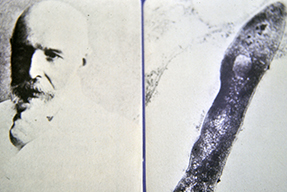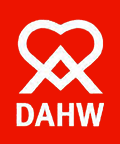Step by step towards a leprosy-free world

The disease leprosy is mentioned in the Bible as well as hundreds of years before Christ in Indian and Chinese traditions and on Egyptian papyri.
The medically verifiable history of leprosy begins in 1873: the Norwegian Gerhard Armauer Hansen discovers and describes the causative pathogen, Mycobacterium leprae. This is why leprosy is still known today as "Hansen's disease" or simply "Hansen's disease".
1915: A woman paves the way
At the beginning of the 20th century, leprosy was an incurable disease and those affected were isolated in so-called leper colonies. The oil from the seeds of the Indian chaulmoogra tree had been used to treat leprosy since around the 14th century - but only for external use, as it was too viscous to inject and the procedure was very painful.
In 1915, the African-American chemist Alice Ball (* July 24, 1892 in Seattle, Washington, † December 31, 1916), who worked as a researcher and lecturer at the College of Hawaii, developed a technique with which the ethyl ester components could be isolated from the fatty acids of chaulmoogra oil. This water-soluble, antibacterial chaulmoograic acid could be dissolved in the bloodstream and was therefore injectable.
The injection inhibited the growth of mycobacteria such as the leprosy pathogen Mycobacterium leprae and the tuberculosis pathogen Mycobacterium tuberculosis. The patients were not cured, but they did not develop any further symptoms. The isolated ethyl ester components were used to treat leprosy until well into the 1940s. Alice Ball thus laid the foundation for the cure of leprosy - at the age of just 23.
However, she did not live to see her success: she died before she could publish the results of her research. (Source: Wikipedia)
1941: First antibiotic against leprosy
The centuries-long policy of isolation and purely symptomatic treatment of leprosy patients in so-called leprosariums was revolutionized in the 1940s.
The American physician Guy Henry Faget (1891 - 1947), director of the leprosarium in Carville / USA, began treating leprosy patients with sulphon preparations in 1940. Sulphonamides are a group of synthetic chemical compounds with an antimicrobial effect that are also used as antibiotics. Treatment with the chemotherapeutic agents proved to be
1968: Leprosy develops resistance
When resistance to the most commonly used leprosy drug at the time was discovered in 1968, DAHW Deutsche Lepra- und Tuberkulosehilfe e. V. (German Leprosy and Tuberculosis Relief Association) launched a large-scale research project in collaboration with the Borstel Research Institute to develop a new therapy against the bacterial infectious disease: The aim is to finally combat the leprosy pathogen effectively and provide a medical cure for those affected.
1983: Leprosy is curable!
Following a successful study in Malta, the World Health Organization (WHO) recommends the newly developed six to twelve-month "MDT" (multi-drug therapy), a mixture of the antibiotics rifampicin, dapsone and clofazimine, as the global standard.
1990: Visible successes
According to WHO statistics, only around 800,000 new cases were recorded worldwide in 1990 - in the 1980s there were still around 5.4 million. This success is not only due to the introduction of free multi-medication therapy: the establishment and expansion of state leprosy control programs with significant involvement of DAHW also contributes to this.
2000: Supposedly eliminated
In the year 2000, leprosy is no longer considered a global health problem according to WHO criteria, as there is only one case of leprosy per 10,000 inhabitants worldwide. As a result, global awareness of the disease is declining: leprosy is no longer part of medical training in many countries and leprosy research activities are also on the decline. As a result, there are still around 250,000 new cases every year, including many in children.
2013: New commitment to research
In 2013, DAHW begins to intensify its commitment to research together with other players in the fight against leprosy in view of the continuing high number of cases. The projects initiated include the development of a leprosy vaccine and the search for methods for early diagnosis and prophylaxis.
As early as 2008, DAHW partner organizations proved in the study "Contact transmission and chemoprophylaxis in leprosy" (COLEP) that a single dose of the antibiotic rifampicin for contact persons of leprosy patients interrupts the transmission of leprosy by 60 percent.
In the follow-up study "Leprosy Post-Exposure Prophylaxis" (LPEP), which was carried out from 2015 to 2019, DAHW, in cooperation with the Novartis Foundation, several scientific institutes and other NGOs, succeeded in positively testing the applicability of LPEP.
Since 2018, the WHO has recommended this PEP as a standard measure to contain the spread of leprosy.
2019: First EU-funded leprosy research project
The "Post Exposure Prophylaxis For Leprosy" study (PEP4LEP) started in 2019: Together with the Dutch Leprosy Relief Association NLR, the national health programs in Ethiopia, Tanzania and Mozambique and the Erasmus University in Rotterdam, DAHW will spend four years investigating how leprosy prophylaxis LPEP can be most effectively integrated into health programs. The project is funded by the European & Developing Countries Clinical Trials Partnership - EDCTP and the Leprosy Research Initiative - LRI. This is the first time that EU funds have been used in leprosy research.
2020: On the "last mile" ...
In 2020, the WHO is publishing a "road map" for the actual elimination of leprosy and other NTDs by 2030. This time, the disease is to be eradicated step by step in individual countries - with "eradicated" meaning that there will in fact no longer be a single new case of leprosy in these countries.
The newly founded "Global Partnership Zero Leprosy" (GPZL) extends the goal: it not only calls for a world with "zero cases of leprosy", but also "zero disability" and "zero discrimination" due to leprosy (Zero Leprosy - Zero Disability - Zero Discrimination).


